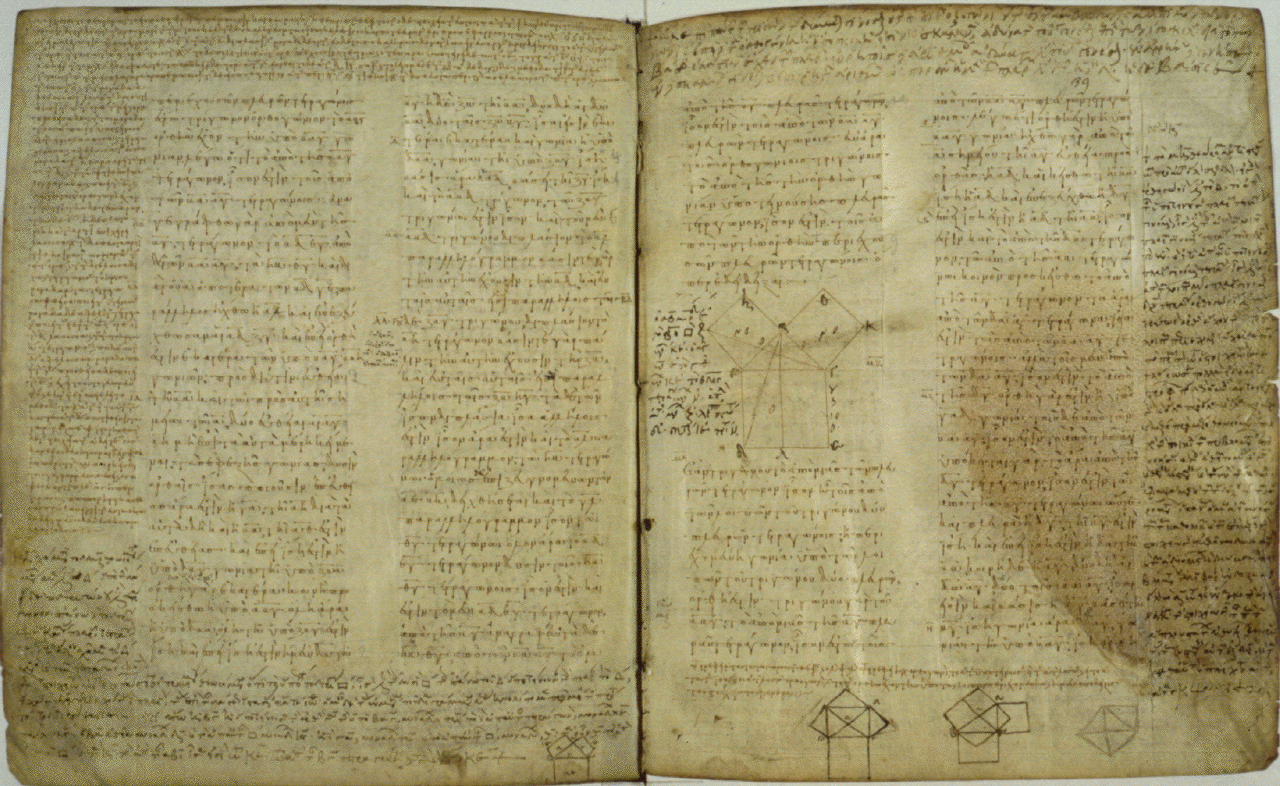Return to the Beginning of the Rome
Reborn exhibit

Rome Reborn: The Vatican Library & Renaissance Culture
MATHEMATICS
MATHEMATICS
Ancient Science and Its Modern Fates
Until recently, historians of the Scientific Revolution of the 16th
and 17th centuries treated it as a kind of rebellion against the authority
of ancient books and humanist scholarship. In fact, however, it began with
the revival of several tremendously important and formidably difficult
works of Greek science. The mathematics and astronomy of the Greeks had
been known in medieval western Europe only through often imperfect translations,
some of them made from Arabic intermediary texts rather than the Greek
originals. The papal curia became a center for the recovery of the original
Greek manuscripts, often very old and remarkably elegant, and the production
of new translations of these works. Ptolemy's "Geography"--the book which
inspired Columbus to attempt his voyage, and remains the model of all systematic
atlases--was dedicated to Popes Gregory XII and Alexander V by its first
translator, the apostolic secretary Jacopo Angeli. Illustrated texts of
this elegant atlas found readers everywhere in Europe. Nicholas V supported
translations of the greatest of Greek mathematicians, Archimedes,
and the greatest of Greek astronomers, Ptolemy. Cardinal Bessarion collected
a vast range of Greek texts (which eventually wound up in Venice, as the
nucleus of another great Renaissance library). A scholar whom he helped
in many ways, Joannes Regiomontanus, became the first western European
in centuries really to master Ptolemy's astronomy, which had been preserved
and improved in the Islamic world. His work done in and for the curia laid
the essential foundations on which Copernicus and other innovators built
a new astronomy in the sixteenth century, using the Greek texts as their
basic source of data and methods. Scholarship supported science in this
world where faith and science were not yet seen as two, irreconcilable
cultures.
GREEK MATHEMATICS AND ITS MODERN HEIRS
ClassicalRoots of the Scientific Revolution
For over a thousand years--from the fifth century B.C. to the fifth
century A.D.--Greek mathematicians maintained a splendid tradition of work
in the exact sciences: mathematics, astronomy, and related fields. Though
the early synthesis of Euclid and some of the supremely brilliant works
of Archimedes were known in the medieval west, this tradition really survived
elsewhere. In Byzantium, the capital of the Greek-speaking Eastern empire,
the original Greek texts were copied and preserved. In the Islamic world,
in locales that ranged from Spain to Persia, the texts were studied in
Arabic translations and fundamental new work was done. The Vatican Library
has one of the richest collections in the world of the products of this
tradition, in all its languages and forms. Both the manuscripts that the
Vatican collected and the work done on them in Rome proved vital to the
recovery of ancient science--which, in turn, laid the foundation for the
Scientific Revolution of the 16th and 17th centuries. In the Roman Renaissance,
science and humanistic scholarship were not only not enemies; they were
natural allies.
 Euclid,
Elements
Ninth
century
Euclid,
Elements
Ninth
century
Euclid's Elements, written about 300 B.C., a comprehensive treatise
on geometry, proportions, and the theory of numbers, is the most long-lived
of all mathematical works. This manuscript preserves an early version of
the text. Shown here is Book I Proposition 47, the Pythagorean Theorem:
the square on the hypotenuse of a right triangle is equal to the sum of
the squares on the sides. This is a famous and important theorem that receives
many notes in the manuscript.
-
Piero della Francesca, De
quinque corporibus regularibus
-
In Latin
Parchment
1480s
The early Renaissance artist Piero della Francesca developed a mathematically
rigorous system of perspective on which he wrote the treatise De prospectiva
pingendi. His interest in mathematics increased as he grew older and
late in his life he wrote two other treatises, a Trattato d'abaco,
on algebra and the measurement of polygons and polyhedra (solids), and
"De quinque corporibus regularibus," on the five regular polyhedra, which
survives only in this unique manuscript from the library of the Duke of
Urbino. The figures are said to be by Piero himself. Shown here are the
inscriptions of an icosahedron (a solid composed of twenty equilateral
triangular faces) in a cube, and of
a cube in an octahedron (a solid of eight equilateral triangular faces).
-
Euclid,
Optics
-
In Latin
Parchment
1458
Euclid's Optics is the earliest surviving work on geometrical optics,
and is generally found in Greek manuscripts along with elementary works
on spherical astronomy. There were a number of medieval Latin translations,
which became of new importance in the fifteenth century for the theory
of linear perspective. This technique is beautifully illustrated here in
the miniature of a street scene in this elegant manuscript from the library
of the Duke of Urbino. It may once have been in the possession of Piero
della Francesca, who wrote one of the principal treatises on perspective
in painting.
-
Astronomical-Mathematical Collection
-
In Greek
Parchment
Tenth century
This is the oldest and best manuscript of a collection of early Greek astronomical
works, mostly elementary, by Autolycus, Euclid, Aristarchus, Hypsicles,
and Theodosius, as well as mathematical works. The most interesting, really
curious, of these is Aristarchus's On the Distances and Sizes of the
Sun and Moon, in which he shows that the sun is between 18 and 20 times
the distance of the moon. Shown here is Proposition 13, with many scholia,
concerned with the ratio to the diameters of the moon and sun of the line
subtending the arc dividing the light and dark portions of the moon in
a lunar eclipse.
Object Omitted from Exhibit
-
Euclid,
Elements
-
In Greek
Parchment
Ninth century
This plate from the same manuscript of Euclid's Elements as Vat.
gr. 190, vol. 1, shows Book XI Propositions 31-33 on the volumes of parallelpipedal
solids. The figures are excellent early representations of three dimensional
objects in a plane.
Return to the Beginning of Rome Reborn exhibit

Comments: lcweb@loc.gov (04/12/96)